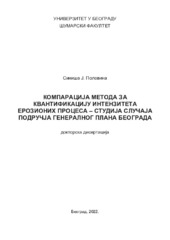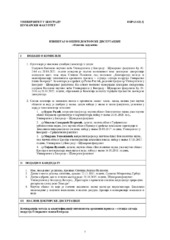Приказ основних података о дисертацији
Компарација метода за квантификацију интензитета ерозионих процеса: студија случаја подручја генералног плана Београда
Comparison of methods for quantifying erosion processes intensity : ǂа ǂcase study of the Belgrade master plan area doctoral dissertation
| dc.contributor.advisor | Ristić, Ratko | |
| dc.contributor.other | Radić, Boris | |
| dc.contributor.other | Samardžić, Mileva | |
| dc.contributor.other | Todosijević, Mirjana | |
| dc.contributor.other | Vulević, Tijana | |
| dc.creator | Polovina, Siniša | |
| dc.date.accessioned | 2024-01-31T14:43:03Z | |
| dc.date.available | 2024-01-31T14:43:03Z | |
| dc.date.issued | 2022-04-21 | |
| dc.identifier.uri | https://eteze.bg.ac.rs/application/showtheses?thesesId=9504 | |
| dc.identifier.uri | https://fedorabg.bg.ac.rs/fedora/get/o:32638/bdef:Content/download | |
| dc.identifier.uri | https://plus.cobiss.net/cobiss/sr/sr/bib/64705289 | |
| dc.identifier.uri | https://nardus.mpn.gov.rs/handle/123456789/22108 | |
| dc.description.abstract | Ерозија земљишта представља сложен еколошки проблем, природног и антропогено индукованог порекла, присутан на глобалном нивоу, са негативним последицама по квалитет животне средине, очување и расположивост природних ресурса, безбедност становништва и материјалну сигурност, подједнако у руралним и урбаним пределима. Убрзани раст броја становника и ширење урбанизованих површина доводе до изражених промена у намени и структури земљишног покривача, услед трансформације пољопривредних и шумских, као и природних и природи блиских површина, у непорозне површине. Услед деловања ових процеса, углавном стихијског карактера, савремени градови као генератори промена представљају „отворене лабораторије“ за детекцију глобалних трендова, али истовремено и за проналажење модалитета за њихово ублажавање. Репрезентативан пример оваквог просторног процеса је подручје урбаног предела Београда, односно територија за коју се израђује Генерални урбанистички план (ГУП), на површини од 778,54 km2 . ГУП представља основни просторно-плански и урбанистички инструмент за реализацију концепта одрживог развоја подручја Београда, кроз систем смерница које дефинишу концепцију развоја, уређивања и заштите града. Реализација решења предвиђених ГУП-ом, у савременом контексту, подразумева коришћење репрезентативних база података о актуелним и прогнозираним ерозионом процесима, у погледу просторне дистрибуције и интензитета. У оквиру овог рада, анализа је обављена за два временска пресека (2001. и 2019. година), где је један од основних показатеља стање структуре земљишног покривача у 2001. години, уз анализу климатских показатеља за период од 1971. до 2001. године. Такође, обављена је анализа стања земљишног покривача у 2019. години, уз коришћење RCP8.5 климатског сценарија који је очекиван за средину XXI века (2046-2065. година). Примењена су три емпиријска ерозиона модела: Метод Потенцијала ерозије (МПЕ), Ревидирана универзална једначина за прорачун губитка земљишта (Revised Universal Soil Loss Equation–RUSLE) и Geoland 2 (G2). Имплементација ерозионих модела у урбаним условима, уз примену различитих климатских сценарија, кроз квантификацију динамике промена структуре површина, обављена је применом савремене методологије, са резултатима који су апликативни у процесу израде планских докумената и креирању решења за контролу и ублажавање ефеката деловања деструктивних ерозионих процеса, брзог површинског отицаја и појаве бујичних поплава. | sr |
| dc.description.abstract | Soil erosion is a complex environmental problem of natural and anthropogenically induced origin, which is present on a global scale, with negative consequences for environmental quality, conservation and availability of natural resources, population safety and material security, both in rural and urban areas. Accelerated population growth and the expansion of urban areas lead to marked changes in the purpose and structure of land cover, due to the transformation of both agricultural and forest areas, and natural and close-to-nature areas into non-porous areas. Due to the effects of these mostly spontaneous processes, modern cities as generators of change are "open laboratories" for detecting global trends, but also for finding modalities to mitigate them. A representative example of such a spatial process can be observed in the urban landscape of Belgrade, i.e. the territory for which the Master Plan (MP) is produced, on an area of 778,54 km2 . The MP is the basic spatial-planning and urban instrument for the realization of the concept of sustainable development of the Belgrade area, through a system of guidelines that define the concept of development, regulation and protection of the city. In the modern context, the implementation of solutions envisaged by the MP implies the use of representative databases on current and forecasted erosion processes in terms of spatial distribution and intensity. In this research, the analysis was performed for two time sections (2001 and 2019), while one of the basic indicators is the state of the land cover structure in 2001, with the analysis of climate indicators for the period 1971-2001. In addition, an analysis of the state of land cover in 2019 was performed, using the RCP8.5 climate scenario expected for the middle of the 21st century (2046- 2065). Three empirical erosion models have been applied: the Erosion Potential Method (EPM), the Revised Universal Soil Loss Equation (RUSLE) and Geoland 2 (G2). The implementation of erosion models was performed using modern methodology in urban conditions with the application of different climate scenarios through the quantification of change dynamics in the surface structure. The related results are applicable in the process of drafting planning documents and creating solutions to control and mitigate the effects of destructive erosion processes, fast surface runoff and the occurrence of torrential floods. | en |
| dc.format | application/pdf | |
| dc.language | sr | |
| dc.publisher | Универзитет у Београду, Шумарски факултет | sr |
| dc.rights | openAccess | en |
| dc.rights.uri | https://creativecommons.org/licenses/by-nc/4.0/ | |
| dc.source | Универзитет у Београду | sr |
| dc.subject | ерозија земљишта, ерозиони модели, урбани предели, даљинска детекција, структура земљишног покривача, Метод Потенцијала ерозије, RUSLE, G2 | sr |
| dc.subject | soil erosion, erosion models, urban landscapes, remote sensing, land cover structure, Erosion Potential Method, RUSLE, G2 | en |
| dc.title | Компарација метода за квантификацију интензитета ерозионих процеса: студија случаја подручја генералног плана Београда | sr |
| dc.title.alternative | Comparison of methods for quantifying erosion processes intensity : ǂа ǂcase study of the Belgrade master plan area doctoral dissertation | en |
| dc.type | doctoralThesis | |
| dc.rights.license | BY-NC | |
| dc.identifier.fulltext | http://nardus.mpn.gov.rs/bitstream/id/158721/Disertacija_14758.pdf | |
| dc.identifier.fulltext | http://nardus.mpn.gov.rs/bitstream/id/158722/Izvestaj_Komisije_14758.pdf | |
| dc.identifier.rcub | https://hdl.handle.net/21.15107/rcub_nardus_22108 |



